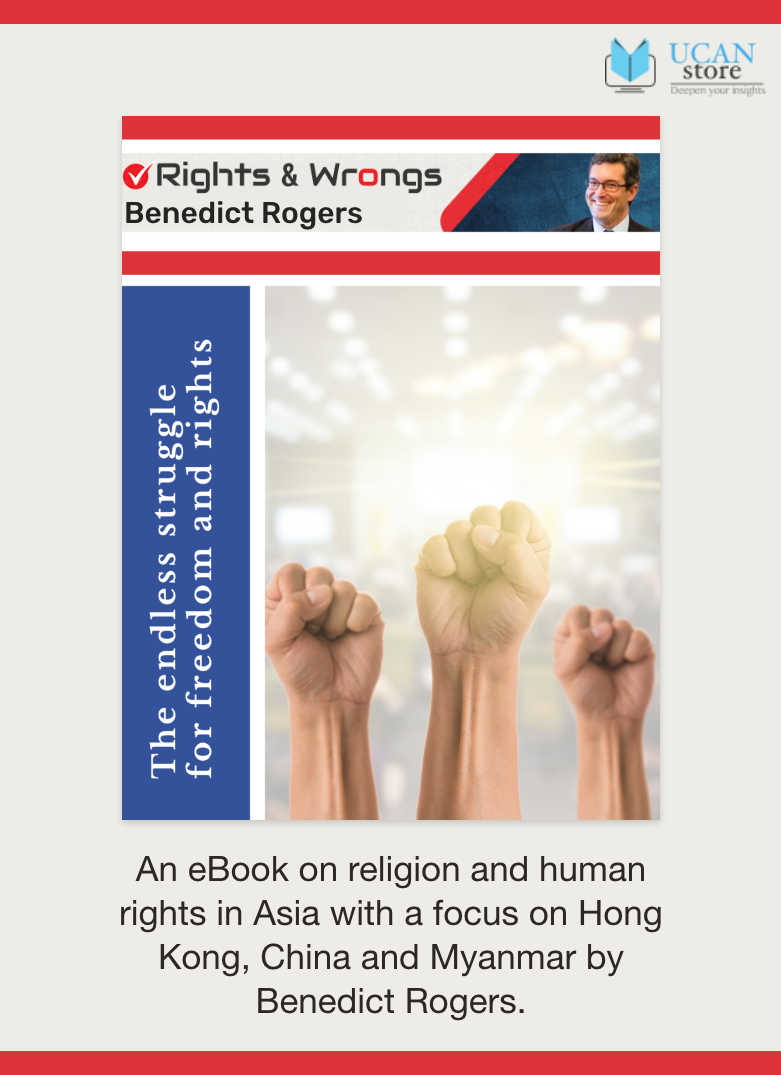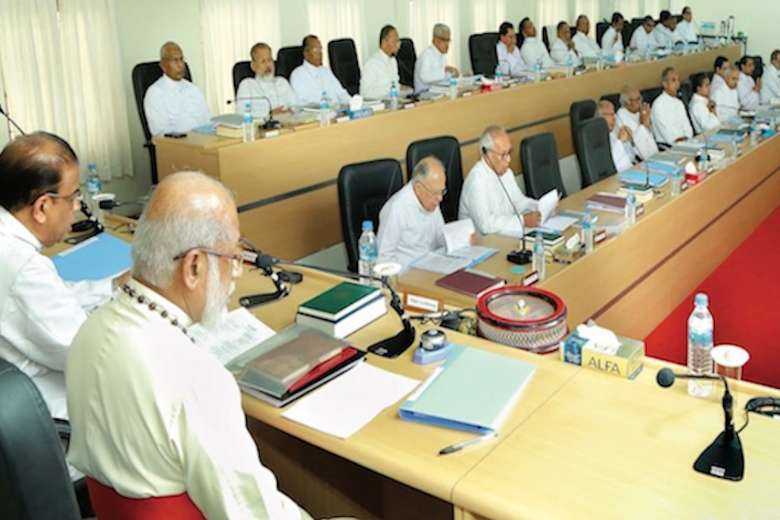
The Syro-Malabar Synod of Bishops imposing a uniform liturgy goes against Catholic traditions and teachings

A session of the Syro-Malabar Synod of Bishops in January 2019. (Photo supplied)
India’s Eastern-rite Syro-Malabar Catholic Church is waging a battle within for uniformity of celebrating Mass, while its major archbishop is facing the heat over a controversial land deal.
Pope Francis’ letter on July 3 had exhorted “all the clergy, religious and lay faithful to proceed to a prompt implementation of the uniform mode of celebrating the Holy Qurbana, for the greater good and unity of your church.”
This was a clever move to divert people’s attention away from the land case.
The exhortation of the pope did not come as a response to an official request made by the Syro-Malabar Synod of Bishops. The synod had only asked the pope for the approval of the revised Malayalam Raza Qurbana Taksa, or missal, which was made after consulting the entire church.
The question of a 50-50 uniformity formula was never included in the consultation, either with the clergy or with the faithful. This decision of the synod in 1999 could not be executed because of disagreement in some dioceses whose priests celebrated Mass facing the people.
The uniform 50-50 orientation meant celebrating the Liturgy of the Word facing the people, and the Liturgy of the Eucharist facing the altar.
Over the course of the last century, we all saw how the dictatorship of uniform thought ended up killing many, many people
Then, whose move was it to get a papal letter in favor of the uniform mode? Surely, it was not an initiative taken by the pope. He just signed a letter presented to him.
The letter immediately became a matter of dispute. The priests of Ernakulam-Angamaly Archdiocese said it went contrary to the opinion expressed by the pope in his earlier talks and speeches.
“The phenomenon of uniform thought [has been],” the pope cautioned, “a misfortune throughout human history.”
“Over the course of the last century, we all saw how the dictatorship of uniform thought ended up killing many, many people.”
“Today, too, a dictatorship of uniform thought exists and this dictatorship is the same.” (Pope Francis, Dictatorship of uniformity, April 10, 2014).
Pope Francis further said: “[The Church] must never become a body in conflict, with winners and losers, for in this way she would spread apprehension, become more rigid and less synodal, and impose a uniformity far removed from the richness and plurality that the Spirit has bestowed on his Church.’’
“I would like now to reflect upon some themes which I consider important. The first is unity in diversity. Uniformity is not Catholic, it is not Christian. Rather, unity in diversity.” (Papal address to the Catholic Fraternity of Charismatic Covenant Communities and Fellowships, Oct. 31, 2014)
The pope, in his letter to the Syro-Malabar Church, added: “I confirm their ecclesial ‘walking together’ with God’s people, trusting that ‘time is greater than space.’” (cf. Evangelii Gaudium, 222-225) and that “unity prevails over conflict” (cf. ibid, 226-230).
Faith on the level of authority has become an ideology among other ideologies. There is an exaggerated doctrinal certainty. It prefers the short-term, present-centric perspective that inevitably results. It is temptation “to possess all the spaces of power and of self-assertion” (Evangelii Gaudium, §223).
The institutions of the Church thus become ends in themselves.
Pope Francis proposes that priority be given to actions, “which generate new processes in society.” He says, “It is more important to start processes than to dominate space.” (Amoris Laetitia, §261). He is for patience and for selfless generativity. What Francis describes as the “tension between fullness and limitation” is a challenge of any social ministry or transformative politics. “Solidarity, in its deepest and most challenging sense, thus becomes a way of making history in a life setting where conflicts, tensions and oppositions can achieve a diversified and life-giving unity” (Evangelii Gaudium, §228).
While addressing the Syro-Malabar synod on Aug. 17, Archbishop Leopoldo Girelli, the apostolic nuncio to India, clarified that “in the present situation of your church, the Holy Father’s desire for a ‘prompt implementation of the uniform mode of celebrating’ is an appeal to unity and not to cause division, and thus needs to be contextualized. Therefore, I encourage the synod judiciously to evaluate the timeframe for a prudent process of implementation in order to safeguard the unity of your church.”
The final words of the nuncio are very important: “Nevertheless, and precisely to avoid unnecessary conflict and preserve communion, I would invite you to encourage all your clergy humbly to accept the decision of the Holy Synod on liturgical unity, so clearly endorsed by the Holy Father Francis.” His appeal is to accept the decision on “liturgical unity” and not uniformity to “avoid conflict and preserve communion.”
This stand of the nuncio is fully in agreement with the Conciliar positions of the Church and of Pope Francis. Karl Rahner wrote: “The consummation of unity in accepting the absolute otherness of everyone else (in accepting this other as one’s very own) and thus the reconciliation between universal unity and enduring plurality, which itself is accepted as good, as its own, by the loving subject.” (Karl Rahner, Unity of the Church — Unity of Mankind. In Concern for the Church, New York: Crossroad, 1981, p. 157.)
The Christian God is not first one and then three, but simultaneously one and three. The general is inconceivable without the particular. If we accept that the Holy Spirit constitutes the Christ-event, Christ is born of the Spirit, anointed by him, accompanied by him in his passion and raised by him from the dead, we are led to the conclusion that Christ is inconceivable without this body, i.e. the “many” who form his body by the operation of the Spirit.
Synodality is an institution aimed precisely at safeguarding the right balance between the 'one' and the 'many,' or between unity and diversity
The essence of the problem lies, Ioannis Zizioulas says, in the extent to which we are prepared to allow a primary and constitutive role for the local Church in ecclesiology. “If we do that, diversity becomes automatically of the essence of the Church, because the basic and fundamental meaning of the diversity is not moral but ontological. Diversity is necessary in the Church not because, for various reasons, it is a morally good thing, but because without it the Church ceases to exist. This can make sense only if the Church is primarily a local reality.”
Synodality is an institution aimed precisely at safeguarding the right balance between the “one” and the “many,” or between unity and diversity. In the first place, there is an understanding of synodality as a mere instrument of consultation, while the final decisions are to be made by some other institution whose authority is higher and final. This sacrifices the integrity of the local Church to the universal Church.
On the other hand, there has been an understanding of the synodical institution as an authority standing above the local Church and imposing its decisions on it. This is what the movement of Conciliarism intended to do by replacing the authority of the pope with that of the Council. In this case, too, the local Church is in danger of ceasing to be a full and integral church.
Synods should never be understood as institutions standing above local churches; they exist as instruments of communion of these churches so that their unity may emerge as a symphonia of diverse ways of living the same Gospel integrity. The universal Church is not an institution above the local churches but a communion of full and Catholic churches. Unity does not destroy diversity.
“When the Church is viewed in terms of conflict — right versus left, progressive versus traditionalist — she becomes fragmented and polarized, distorting and betraying her true nature. She is, on the other hand, a body in continual crisis, precisely because she is alive. She must never become a body in conflict, with winners and losers, for in this way she would spread apprehension, become more rigid and less synodal, and impose a uniformity far removed from the richness and plurality that the Spirit has bestowed on his Church.” (Papal address to Roman Curia, Dec. 21, 2020)
“That treasure is Tradition, which, as Benedict XVI recalled, “is the living river that links us to the origins, the living river in which the origins are ever-present, the great river that leads us to the gates of eternity” (Catechesis, April 26, 2006). I think of the saying of that great German musician: “Tradition is the guarantee of the future, not a museum, an urn of ashes.”
The essence of language is goodness, or again, that the essence of language is friendship and hospitality
Imposition of the liturgy of this sort is embarrassing. The same ordo of the Eucharistic in the Syro-Malabar Church is celebrated with a plurality of ways and modes. It can be solemn and ordinary celebrations in varying tunes and styles, it can be the requiem sung or said. The variety adds to its color and vitality. Time is greater than space. Let us be patient and responsive to the Spirit speaking through the people of God.
In Christianity turning to God is turning to man. The face of man is the epiphany of Christ. Jacob is coming back fleeing from Laban. He is afraid of his brother Esau who he has cheated. As he crosses the river, he wrestled with God in the night. He is defeated and wounded; he sees his brother approaching him with his people. There is the possibility of war. But he goes to his brother and embraces him saying, “I see your face as I see the face of God” (Gen. 33:10).
When we turn to man, hospitality and communion emerge. The epiphany of the face in the face to face. “The essence of language is goodness, or again, that the essence of language is friendship and hospitality.” (E. Levinas, Totality and Infinity, p. 205)
The Syro-Malabar Synod of Bishops, just concluded on Aug. 27, proved that there is no more consensus on uniformity. A third of the synod is very clearly against imposing uniformity.
The majority have decided to execute their decision as the advent season begins. It is reported that the synod did not even permit the registration of the minority dissent.
The sad situation is that the synod became less than a parliament.
Father Paul Thelakat is a Catholic priest of the Eastern-rite Syro-Malabar Church and former spokesman of its Synod of Bishops. He is editor of Light of Truth, a church-run biweekly from Kochi. The opinions expressed in this article are those of the author and do not necessarily reflect the official editorial position of UCA News.
Help us keep UCA News independent
The Church in Asia needs objective and independent journalism to speak the truth about the Church and the state.
With a network of professionally qualified journalists and editors across Asia, UCA News is just about meeting that need. But professionalism does not come cheap. We depend on you, our readers, to help maintain our independence and seek that truth.
A small donation of US$2 a month would make a big difference in our quest to achieve our goal.

Share your comments